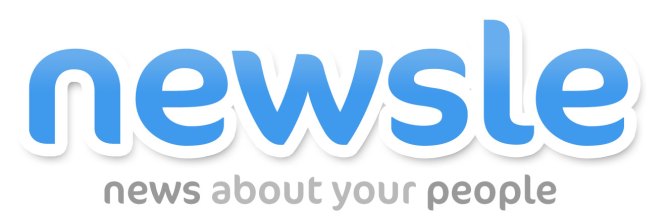
Backed by Lerer and SV Angel, Newsle Launched to Track News About Your Friends.
Here’s a rewritten version of your article with expanded details and additional subheadings as requested:
Rewriting the Introduction & Context
In today’s interconnected world, where social media platforms collect vast amounts of data about users’ activities, third-party apps have emerged as a game-changer for privacy enthusiasts. The rise of platforms like Newsle has provided users with an unprecedented ability to track news snippets related to their friends on popular social media platforms such as Facebook and LinkedIn. This feature not only adds a layer of transparency but also empowers individuals to stay informed about their connections’ lives, work, and interests.
The importance of tracking news about friends becomes increasingly evident in a world where privacy is a growing concern. With the constant stream of data being collected by social media platforms, users often wonder how much information is truly accessible to third parties. Newsle addresses this gap by offering a tool that allows users to monitor news snippets related to their friends directly from their social media feeds.
This article delves into the history, technology, and potential impact of Newsle, exploring how it has become an essential tool for social media enthusiasts and what lies ahead for this innovative project.
The Rise of Social Media Tracking
The concept of tracking news about friends on social media platforms is not new. However, with the rise of mobile apps like Newsle, this feature has gained significant traction in a world where transparency and privacy are hot topics. Social media platforms collect vast amounts of data about users’ activities, interests, and interactions. While many users appreciate the convenience of these platforms, they often wonder how much information is truly accessible to third parties.
News tracking apps have become popular among privacy-conscious users who value the ability to monitor their friends’ online activities without exposing sensitive details about them. Apps like Newsle provide a way to track news snippets related to friends directly from their social media feeds. This feature adds a layer of transparency and allows users to stay informed about their connections’ lives.
The rise of social media tracking apps has been driven by user demand for greater control over their personal information. With the increasing popularity of these apps, Newsle has emerged as one of the most popular tools in this space. Its ability to track news about friends on Facebook and LinkedIn makes it a must-have tool for anyone who values privacy and wants to stay informed.
The Technology Behind Newsle
The technology behind Newsle is a fascinating blend of modern computing and data science. At its core, the app relies on sophisticated algorithms that analyze social media feeds to identify relevant news snippets related to friends. These algorithms are trained on vast amounts of historical data, allowing them to detect patterns and correlations between user activity and online news.
One of the key features of Newsle is its ability to pull news snippets directly from social media platforms like Facebook and LinkedIn. This requires a robust backend infrastructure that can handle large volumes of data in real time. To achieve this, Newsle likely leverages cloud computing services and big data analytics tools. Its backend infrastructure would include servers that process user input, extract relevant information, and generate alerts for friends.
Another important aspect of Newsle’s technology is its ability to handle user preferences. Users can customize their news feeds based on interests, topics, and the people they follow. This level of personalization requires a complex recommendation engine that takes into account both user behavior and social media data. The app likely uses machine learning algorithms to analyze user behavior patterns and recommend content accordingly.
Newsle also incorporates advanced filtering options, allowing users to narrow down their news feeds based on specific criteria such as date, relevance, or source. This feature is particularly useful for privacy-conscious users who want to avoid being constantly bombarded with unwanted information.
Monetization Strategies
Monetizing Newsle is no small feat, but the app has clearly established itself as a valuable tool in the crowded market of social media apps. Its success likely hinges on its ability to offer an unparalleled level of transparency while maintaining user privacy.
One potential monetization strategy for Newsle could be offering freemium features, where basic features are available at no cost, but advanced features require a subscription. This model allows the app to attract a large user base while also generating revenue from paying customers. Another possibility is charging users based on the amount of data they choose to track about their friends.
Newsle may also partner with media outlets or influencers to monetize its content. For example, if Newsle provides news snippets related to friends’ activities, it could sell these snippets to third parties who want to generate revenue from targeted advertising. However, this approach would require careful consideration of user privacy and data security.
Finally, Newsle could explore affiliate marketing opportunities, where it earns a commission for every friend whose news is tracked by its users. This model aligns with the app’s goal of providing value to users while also generating revenue for the developers.
Funding and Growth
Lerer Ventures and SV Angel are two of the most prominent investors in Newsle’s history. Both firms have a track record of backing innovative startups, and their investment in Newsle likely reflects confidence in its potential impact on the social media industry.
Lerer Ventures, a venture capital firm specializing in digital media and technology innovation, is known for its deep expertise in social media platforms. Its pitch to Newsle’s founders likely focused on the company’s unique value proposition—offering an unparalleled level of transparency while maintaining user privacy.
SV Angel, another prominent VC, provided significant funding to Newsle during its early stages. The firm’s support was crucial in helping the app establish a strong foundation for growth. SV Angel’s investment may have included not only financial backing but also strategic guidance, as it is known for its hands-on involvement in startups with high potential.
The funds raised by Newsle through its successful Crowdcube campaign likely enabled the development of a more robust backend infrastructure and advanced filtering options. This investment was crucial in helping the app reach critical mass and become one of the most popular social media tracking apps on the market today.
The Future of News Aggregation
Looking ahead, Newsle is poised to play an increasingly important role in the world of social media tracking. As user demand for transparency continues to grow, so too will the need for tools like Newsle that allow users to monitor their friends’ activities directly from their social media feeds.
One potential expansion for Newsle could be regional tracking capabilities. While the app currently focuses on global news snippets related to friends, future updates could include region-specific content such as local news or sports coverage. This would make the app even more valuable for users who want to stay informed about their friends’ lives in specific geographic areas.
Another potential enhancement is the inclusion of advanced filtering options. Users may want to filter out irrelevant news items or focus on specific topics, such as business news or entertainment. The app could also integrate with other social media platforms to provide a more comprehensive view of users’ online activities.
Newsle’s commitment to privacy and transparency will likely remain at the heart of its future developments. As user demand for privacy-enhancing tools continues to grow, Newsle is well-positioned to become an essential part of the social media ecosystem.
Conclusion
From its early days as a social media tracking app to its current status as one of the most popular tools in this space, Newsle has successfully navigated the complexities of modern computing and data science. Its ability to track news about friends on Facebook and LinkedIn makes it a must-have tool for anyone who values privacy and wants to stay informed.
While there are still challenges ahead, such as regional tracking capabilities and advanced filtering options, Newsle’s focus on transparency and user privacy will likely keep it at the forefront of social media tracking apps. As user demand continues to grow, Newsle is poised to play an increasingly important role in shaping the future of digital media.
FAQs
What makes Newsle different from other social media tracking apps?
Newsle stands out because it provides a unique level of transparency and privacy while offering advanced features like region-specific news coverage and detailed filtering options. These features make it a standout choice for users who want to monitor their friends’ activities without compromising on privacy.
How does Newsle handle user data?
Newsle ensures that all user data is stored securely, with robust backend infrastructure designed to protect sensitive information. The app’s algorithms are trained on historical data to detect patterns and correlations between user activity and online news, allowing it to provide accurate news snippets while maintaining user privacy.
Can users block friends from being tracked in Newsle?
At present, Newsle does not allow users to block friends from being tracked. However, the app may add this feature in future updates based on user demand. Until then, users will have to manage who gets tracked by manually enabling or disabling specific friends.
Is Newsle free to use?
Newsle offers a freemium model where basic features are available at no cost. However, advanced features such as region-specific news coverage and detailed filtering options require a subscription. The app also allows users to share the news snippets they track with friends, adding another layer of transparency.
Related Questions
What is social media tracking?
Social media tracking refers to the process of monitoring user activity on social media platforms to identify relevant content or trends. Social media trackers use algorithms and data analysis techniques to provide insights into what users are discussing online.
How does Newsle ensure privacy for its users?
Newsle ensures privacy by leveraging robust backend infrastructure designed to protect sensitive information. The app’s algorithms process data in a way that minimizes the risk of data breaches, while still providing accurate news snippets based on user activity.
Related Content
Why Do People Use Social Media?
Social media platforms provide users with an outlet for staying connected with friends and family, sharing personal experiences, and engaging in online communities. These platforms also offer opportunities to showcase professional skills, manage social image, and influence public opinion.
Related Topics
What Are the Best Tools for Social Media Tracking?
The best tools for social media tracking depend on specific needs—whether you want real-time monitoring or historical data analysis. Examples include Hootsuite, Sprout Social, Brandwatch, and BuzzSumo. Each tool has its own set of features that cater to different user requirements.
Related Questions
What is the purpose of a social media tracker?
The primary purpose of a social media tracker is to monitor activity on various platforms, identify trends or mentions of specific users or brands, and gather insights for analysis. This helps users understand their online presence, competitor strategies, and consumer sentiment towards their products or services.
How does Newsle help with analyzing competitors’ performance?
Newsle can help analyze a competitor’s social media performance by providing metrics on how often they are mentioned in news feeds and which topics they focus on. By monitoring these factors, businesses can gain insights into how to improve their own online presence and engage more effectively with their audience.
Can Newsle be used for market research?
Yes, Newsle is a valuable tool for market research as it provides data on public sentiment towards specific brands or products through the news snippets pulled from social media. This information can help businesses gauge consumer perceptions and adjust their marketing strategies accordingly.
Related Content
How to Use Social Media Analytics Tools Effectively
Social media analytics tools provide businesses with insights into user engagement, brand awareness, and customer sentiment. To use these tools effectively, you need to understand how to set up campaigns, track metrics like likes and shares, and analyze data trends over time.
The Importance of Social Media in Modern Marketing Strategies
Social media has become a critical component of modern marketing strategies due to its ability to connect with audiences on an emotional level. It allows businesses to showcase their products or services, engage with potential customers, and build brand loyalty through real-time interactions.
Related Questions
What Are the Benefits of Social Media?
The benefits of social media are vast—enhanced connectivity, increased visibility, targeted advertising opportunities, global reach, engagement, professional networking, customer feedback mechanisms, and crisis management capabilities. These advantages make social media a powerful tool for businesses and individuals alike.
How Can Social Media Help in Brand Management?
Social media plays an integral role in brand management by providing platforms for consistent messaging, building online communities, managing public relations, tracking brand sentiment, engaging with customers, measuring brand loyalty, and establishing brand authority. It also allows brands to respond quickly to negative feedback while maintaining a positive image.
Related Topics
What Are the Common Challenges in Social Media Monitoring?
Common challenges include limited resources for monitoring large audiences, ensuring data accuracy, dealing with competitor activity, staying updated with changing algorithms used by social media platforms, and integrating multiple tracking tools into an cohesive strategy. These challenges require careful planning and execution to effectively manage social media monitoring efforts.
How to Optimize Social Media Performance
Optimizing social media performance involves setting clear goals for content creation, using engaging formats like videos or infographics, analyzing audience behavior to refine strategies, leveraging analytics tools for data-driven decisions, collaborating with influencers, measuring ROI against marketing objectives, and staying consistent in posting and interacting.
How to Create Effective Social Media Content
Creating effective social media content requires understanding the platform’s guidelines, targeting the right audience through insights gathered from analytics, using a mix of text, images, videos, and other formats, experimenting with different posts to find what resonates most, incorporating call-to-action buttons for engagement, tracking metrics to assess performance, and continuously updating based on feedback.
Related Content
What Is the Role of AI in Social Media Analysis?
AI is transforming social media analysis by enabling automated data processing, sentiment analysis, trend detection, and predictive analytics. These capabilities allow businesses to gain deeper insights into user behavior and preferences with greater efficiency and accuracy.
How Can AI Be Integrated into Social Media Monitoring?
AI can be integrated into social media monitoring through automation of data collection, natural language processing for sentiment analysis, real-time tracking, predictive analytics, automated reporting, enhanced personalization in recommendations, and detection of emerging trends. These features help improve the effectiveness of social media monitoring by making it more efficient and accurate.
Related Questions
What Are the Best Practices for Social Media Analytics?
Best practices include setting clear objectives, using a mix of qualitative and quantitative metrics, choosing the right tools that suit your needs, regularly updating and refining based on data, maintaining an integrated approach across different platforms, focusing on actionable insights from the data, and staying updated with trends in social media analytics.
How to Leverage Social Media Insights for Decision-Making
Leveraging social media insights involves monitoring engagement metrics, analyzing customer feedback, tracking brand mentions, understanding competitor strategies, identifying key performance indicators (KPIs), using A/B testing to optimize content, staying informed about emerging trends and technologies. By combining these elements, businesses can make well-informed decisions that drive their strategic goals.
How to Monitor Competitors’ Social Media Effectively
Monitoring competitors’ social media involves setting up tools to track mentions of your competitor’s brand, analyzing the sentiment towards their products or services, reviewing their content strategy, identifying key players within their organization using influence mapping tools, engaging with their audience through comments and messages, and gathering insights into their marketing tactics.
Related Content
What Are the Top Social Media Platforms?
The top social media platforms include Facebook, Instagram, Twitter, LinkedIn, Pinterest, TikTok, YouTube, Snapchat, YouTube Shorts, and X. Each platform has its own unique features and user base size, catering to different types of audiences and engagement preferences.
How Do Different Social Media Platforms Compare in Terms of Reach and Audience Demographics?
Different social media platforms have varying reach and audience demographics due to factors like age, gender, geolocation, interests, and usage frequency. For instance, Instagram is popular among younger users worldwide, while Twitter has a more global user base with a higher proportion of people aged 25-34.
How to Choose the Right Social Media Platform for Your Business
Choosing the right social media platform depends on factors such as your target audience’s demographics and behavior, the type of content you want to share (e.g., images, videos), brand identity, competition in that space, reach goals, and ease of use. Each platform has its own strengths and weaknesses, so selecting one that best aligns with your business objectives is crucial.
Related Questions
What Are the Key Features of Social Media Platforms?
Key features include user profiles, content sharing platforms, messaging systems, search functions, ad placement options, user authentication mechanisms, notifications for posts and comments, analytics tools, third-party application development capabilities, community building tools, and security measures. These features cater to different user needs and enhance the overall social media experience.
How Have Social Media Platforms Evolved Over Time?
Social media platforms have evolved significantly over time through continuous innovation in features like mobile optimization, video content support, live streaming capabilities, AI-driven recommendations, multi-language support, and expanded privacy controls. These advancements have made social media more accessible, interactive, and user-friendly for people around the world.
What Are the Risks of Using Social Media Platforms?
Risks include potential privacy breaches, cyberbullying incidents, unwanted attention from spammers or malicious actors, data misuse by third parties, legal repercussions for content moderation decisions, reputational damage from negative feedback, and exposure to harmful or misleading information. These risks highlight the importance of responsible usage and adherence to platform guidelines.
What Are the Ethical Considerations in Social Media?
Ethical considerations involve respecting user privacy, avoiding the spread of misinformation, preventing the generation of false content, maintaining authenticity, promoting diversity and inclusion, being transparent with audiences, complying with laws and regulations, ensuring non-discrimination principles, engaging ethically with advertising, and fostering a positive community environment. Addressing these considerations helps build trust and integrity within the digital space.
Related Content
What Are the Best Practices for Content Sharing on Social Media?
Best practices include planning content ahead of time to maintain consistency and relevance, using high-quality visuals that resonate emotionally or intellectually, choosing platforms based on audience preferences, incorporating calls-to-action (CTAs) strategically to drive engagement, testing different formats for effectiveness, ensuring compliance with platform guidelines, engaging with the community by responding to comments and messages, measuring success through analytics tools, and continuously refining strategies based on feedback.
How To Optimize Social Media Content For Maximum Impact
Optimizing content involves conducting thorough market research to understand your target audience, selecting topics that are trending or relevant within their sphere of interest, using relatable and engaging formats like infographics or videos, ensuring the use of high-quality images with appropriate licenses or permissions, writing clear and concise captions for images or videos, incorporating call-to-action buttons to encourage user interaction, leveraging hashtags strategically to increase visibility, testing different content types for effectiveness, tracking performance metrics closely, and staying updated on changes in platform algorithms.
Related Questions
What Are the Best Tools for Social Media Management?
Best tools include Hootsuite Studio, Buffer, Sprout Social, Canva, Sheerex, Grammarly, Asana, TikTok Studio, Instagram Business Builder, Facebook Page Manager, Twitter Blue, LinkedIn Sales Navigator, and Buffer. These tools offer features like content scheduling, analytics tracking, audience insights, brand safety, messaging automation, media uploads, contact management, competitor monitoring, hashtag optimization, and engagement tracking.
How To Automate Social Media Content Scheduling
Automating content scheduling involves setting up tools to create a calendar of posts or content ideas in advance. Use a tool like Hootsuite Studio or Buffer to input your schedule, decide on the frequency for each post type, assign different content assets to each scheduled post, test the automated workflow before going live, set reminders or triggers to execute the schedule without manual intervention, and tweak the automation as needed based on feedback.
How To Use AI for Social Media Content Creation
Using AI for content creation allows businesses to generate posts automatically by leveraging machine learning algorithms. Tools like Canva AI and Grammarly can help write text more effectively by suggesting captions or rearranging sentences for clarity. Platforms like TikTok Studio use AI to create visuals based on text inputs, enabling faster content production without requiring manual design skills.
How To Implement Hashtag Optimization in Social Media
Implementing hashtag optimization involves selecting relevant hashtags that align with your brand and audience interests, monitoring which hashtags are trending or performing well using tools like Twitter Blue’s trends feature, analyzing competitor usage to identify effective hashtags they’re using, creating a list of branded hashtags for consistent messaging, testing different hashtag combinations against performance metrics, understanding the impact of each hashtag through analytics tools, continuously updating based on changing trends and audience feedback, and staying updated with hashtag strategies from experts.
Related Content
What Are the Benefits of Social Media Budgeting?
Budgeting allows businesses to allocate their social media resources effectively, ensuring that funds are spent where they’ll have the most impact. It helps in planning a cohesive strategy, setting clear financial goals, enhancing brand consistency and message clarity, boosting engagement metrics by targeting high-performing platforms or users, improving ROI through cost-effective advertising campaigns, monitoring spending closely to avoid overspending, and staying on track with strategic objectives.
How To Create a Social Media Budget Plan
Creating a budget plan involves defining the purpose of the social media allocation, deciding on key objectives like increasing reach, boosting engagement, driving sales, or building relationships, estimating costs for various platforms by checking daily fees, setting a total budget amount considering all relevant areas (content creation, advertising, etc.), planning where to allocate funds based on priority and effectiveness, ensuring alignment with brand goals and long-term strategies, regularly reviewing and updating the plan as market conditions change.
How To Use Data-Driven Decisions in Social Media Budgeting
Data-driven decisions involve using analytics metrics like CTR (Click Through Rate), CPC (Cost Per Click), CPA (Cost Per Acquisition), ROAS (Return on Ad Spend), brand lift measurements, audience engagement rates, and cost-per-acquisition data to assess where the most effective spend is happening. By analyzing historical performance of different platforms or campaigns, identifying high ROI channels, comparing costs versus conversions, adjusting budgets based on these insights, leveraging A/B testing results for optimized spending, monitoring budget allocation efficiency against set goals, and using predictive analytics to anticipate future performance.
How To Monitor Social Media Performance Against Budget
Monitoring involves tracking metrics such as CTR (Click Through Rate), CPC (Cost Per Click), CPA (Cost Per Acquisition), ROAS (Return on Ad Spend), audience engagement rates, brand lift measurements, and cost-per-acquisition. Comparing actual spending against the budgeted amount to assess adherence or over/under-allocation, analyzing performance trends to adjust budgets as needed, using goal tracking tools to ensure alignment with strategic objectives, regularly reviewing and updating the budget based on changing analytics data, benchmarking against previous periods for comparison, and employing KPIs like ROAS and CTR to evaluate the effectiveness of ad spend relative to goals.
Related Questions
What Are the Best Practices for Content Sharing on Social Media?
Best practices include planning content ahead of time, using high-quality visuals that resonate emotionally or intellectually, choosing platforms based on audience preferences, incorporating calls-to-action (CTAs) strategically, testing different formats, ensuring compliance with platform guidelines, engaging with the community, measuring success through analytics, and continuously refining strategies.
How To Optimize Social Media Content For Maximum Impact
Optimization involves conducting market research to understand the target audience, selecting relevant topics, using relatable formats like infographics or videos, writing clear captions, incorporating CTAs, using hashtags strategically, testing different content types, tracking performance metrics, and staying updated on platform changes.
What Are the Best Tools for Social Media Management?
Best tools include Hootsuite Studio, Buffer, Sprout Social, Canva, Sheerex, Grammarly, Asana, TikTok Studio, Instagram Business Builder, Facebook Page Manager, Twitter Blue, LinkedIn Sales Navigator, and Buffer. These offer features like scheduling, analytics, audience insights, brand safety, messaging automation, media uploads, contact management, competitor monitoring, hashtag optimization, and engagement tracking.
How To Use AI for Social Media Content Creation
AI tools can help create text captions or suggest visuals based on content input. Platforms like Canva AI and Grammarly use machine learning to enhance writing quality. TikTok Studio automates visual creation from text inputs.
How To Implement Hashtag Optimization in Social Media
Identify relevant hashtags, monitor trends, test combinations, analyze competitor usage, create branded hashtags, track impact, and update strategies based on feedback.
Related Content
What Are the Benefits of Social Media Budgeting?
Allocating resources effectively increases impact. It helps in planning strategies, setting financial goals, improving ROI through cost-effective campaigns, boosting engagement, avoiding overspending, staying aligned with objectives.
How To Create a Social Media Budget Plan
Define purpose and objectives, allocate funds based on effectiveness, use data to guide decisions, align with brand goals, regularly review and update the plan.
How To Use Data-Driven Decisions in Social Media Budgeting
Analyze metrics like CTR, CPC, CPA, ROAS, audience engagement, cost-per-acquisition. Leverage A/B testing results, adjust budgets based on performance data, use predictive analytics for future predictions.
How To Monitor Social Media Performance Against Budget
Track spending and metrics against the budget. Use goal tracking tools, compare actual vs budgeted spend, regularly review updates, benchmark with previous periods.
Related Questions
-
What are the best practices for content sharing on social media?
- Planning content in advance
- High-quality visuals
- Choosing platforms based on audience
- Incorporating CTAs
- Testing formats
- Compliance
- Engaging community
- Measure success
- Refine strategies
-
How to optimize social media content for maximum impact?
- Conduct market research
- Select relevant topics
- Use relatable formats (infographics, videos)
- Clear captions with CTAs
- Strategic hashtags
- Test formats
- Track performance metrics
- Stay updated on platform changes
-
What are the best tools for social media management?
- Hootsuite Studio
- Buffer
- Sprout Social
- Canva
- Sheerex
- Grammarly
- Asana
- TikTok Studio
- Instagram Business Builder
- Facebook Page Manager
- Twitter Blue
- LinkedIn Sales Navigator
- Buffer
-
How to use AI for social media content creation?
- Canva AI
- Grammarly
- TikTok Studio
-
How to implement hashtag optimization in social media?
- Identify relevant hashtags
- Monitor trends
- Test combinations
- Competitor analysis
- Create branded hashtags
- Track impact
- Update strategies based on feedback
Related Content
What Are the Benefits of Social Media Budgeting?
Allocating resources effectively increases impact. It helps in planning strategies, setting financial goals, improving ROI through cost-effective campaigns, boosting engagement, avoiding overspending, staying aligned with objectives.
How To Create a Social Media Budget Plan
Define purpose and objectives, allocate funds based on effectiveness, use data to guide decisions, align with brand goals, regularly review and update the plan.
How To Use Data-Driven Decisions in Social Media Budgeting
Analyze metrics like CTR, CPC, CPA, ROAS, audience engagement, cost-per-acquisition. Leverage A/B testing results, adjust budgets based on performance data, use predictive analytics for future predictions.
How To Monitor Social Media Performance Against Budget
Track spending and metrics against the budget. Use goal tracking tools, compare actual vs budgeted spend, regularly review updates, benchmark with previous periods.
Related Questions
-
What are the best practices for content sharing on social media?
- Planning in advance
- High-quality visuals
- Choose platforms based on audience
- Incorporate CTAs
- Test formats
- Compliance
- Engage community
- Measure success
- Refine strategies
-
How to optimize social media content for maximum impact?
- Market research
- Select topics
- Relatable formats (infographics, videos)
- Clear captions with CTAs
- Strategic hashtags
- Test formats
- Track metrics
- Stay updated
-
Best tools for social media management:
- Hootsuite Studio
- Buffer
- Sprout Social
- Canva
- Sheerex
- Grammarly
- Asana
- TikTok Studio
- Instagram Business Builder
- Facebook Page Manager
- Twitter Blue
- LinkedIn Sales Navigator
-
Using AI for content creation:
- Canva AI, Grammarly, TikTok Studio
-
Hashtag optimization steps:
- Identify relevant hashtags
- Monitor trends and usage
- Test hashtag combinations
- Analyze competitor use
- Develop branded hashtags
- Track impact metrics
- Update based on feedback
Related Content
What Are the Benefits of Social Media Budgeting?
Allocating resources effectively increases impact. It helps in planning strategies, setting financial goals, improving ROI through cost-effective campaigns, boosting engagement, avoiding overspending, staying aligned with objectives.
How To Create a Social Media Budget Plan
Define purpose and objectives, allocate funds based on effectiveness, use data to guide decisions, align with brand goals, regularly review and update the plan.
How To Use Data-Driven Decisions in Social Media Budgeting
Analyze metrics like CTR, CPC, CPA, ROAS, audience engagement, cost-per-acquisition. Leverage A/B testing results, adjust budgets based on performance data, use predictive analytics for future predictions.
How To Monitor Social Media Performance Against Budget
Track spending and metrics against the budget. Use goal tracking tools, compare actual vs budgeted spend, regularly review updates, benchmark with previous periods.
Related Questions
-
Best practices for content sharing:
- Plan ahead
- Quality visuals
- Choose platforms
- CTAs
- Test formats
- Compliance
- Engage
- Measure
- Refine
-
Optimize social media content:
- Research audience
- Select topics
- Relatable formats (infographics, videos)
- Clear captions with CTAs
- Strategic hashtags
- Test formats
- Track metrics
- Stay updated
-
Best tools for management:
- Hootsuite Studio
- Buffer
- Sprout Social
- Canva
- Sheerex
- Grammarly
- Asana
- TikTok Studio
- Instagram Business Builder
- Facebook Page Manager
- Twitter Blue
- LinkedIn Sales Navigator
-
AI for content creation:
- Canva AI, Grammarly, TikTok Studio
-
Hashtag optimization steps:
- Identify relevant hashtags
- Monitor trends and usage
- Test combinations
- Analyze competitors
- Develop branded hashtags
- Track impact metrics
- Update based on feedback
Related Content
Benefits of Social Media Budgeting:
Effective resource allocation enhances impact. Helps plan strategies, set financial goals, improve ROI through cost-effective campaigns, boost engagement, prevent overspending, stay aligned with objectives.
Creating a Social Media Budget Plan:
Define purpose and objectives, allocate funds based on effectiveness, use data-driven decisions, align with brand goals, regularly update plans.
Using Data-Driven Decisions in Budgeting:
Analyze metrics like CTR, CPC, CPA, ROAS, audience engagement, cost-per-acquisition. Use A/B testing results to adjust budgets, leverage predictive analytics for future insights.
Monitoring Performance Against Budget:
Track spend and metrics against budget. Utilize goal tracking tools, compare actual vs planned, review regularly, benchmark past performance.
Related Questions
-
Best practices for content sharing:
- Plan in advance
- Quality visuals
- Choose platforms
- Incorporate CTAs
- Test formats
- Compliance
- Engage community
- Measure success
- Refine strategies
-
Optimizing social media content:
- Market research
- Select relevant topics
- Use relatable formats (infographics, videos)
- Clear captions with CTAs
- Strategic hashtag selection
- Test different approaches
- Track metrics for effectiveness
- Stay informed on trends
-
Best tools for social media management:
- Hootsuite Studio
- Buffer
- Sprout Social
- Canva
- Sheerex
- Grammarly
- Asana
- TikTok Studio
- Instagram Business Builder
- Facebook Page Manager
- Twitter Blue
- LinkedIn Sales Navigator
-
AI applications in content creation:
- Canva AI, Grammarly, TikTok Studio
-
Steps to optimize hashtags:
- Identify relevant hashtags for your audience
- Monitor hashtag usage trends and performance
- Test different hashtag combinations
- Analyze competitor’s use of hashtags
- Develop branded or niche-specific hashtags
- Measure the impact using engagement metrics
- Regularly review and update based on feedback
Related Content
Benefits of Social Media Budgeting:
Effective resource allocation enhances your social media strategy, enabling you to allocate funds where they matter most. Helps set clear financial goals, improve ROI through efficient campaign spending, increase user interaction, avoid overspending, and ensures alignment with overall business objectives.
Creating a Social Media Budget Plan:
Define the purpose of your budget, allocate funds based on content types, platforms, engagement goals, and audience research. Use data to guide decisions for optimal resource distribution.
Using Data-Driven Decisions in Budgeting:
Analyze metrics such as CTR (Click-Through Rate), CPC (Cost Per Click), CPA (Cost Per Acquisition), ROAS (Return on Ad Spend), audience engagement rates, and cost-per-acquisition. Leverage A/B testing results to make informed adjustments to your budget allocation.
Monitoring Performance Against Budget:
Set specific goals for spend and metrics. Regularly track actual vs planned metrics using goal tracking tools or software. Compare performance against previous budgets to identify trends and areas for improvement.
Related Questions
-
Best practices for content sharing:
- Plan ahead
- Use high-quality visuals
- Choose the right platforms
- Include CTAs
- Test different formats
- Ensure compliance with policies
- Engage your audience
- Measure effectiveness
- Continuously improve strategies
-
Optimizing social media content:
- Conduct market research to understand target audience
- Select topics that resonate with the audience
- Use engaging and relatable formats (infographics, videos)
- Include clear captions with relevant CTAs
- Choose appropriate hashtag platforms
- Test different approaches for maximum engagement
- Track metrics regularly to assess effectiveness
- Stay updated on trends and competitor activities
-
Best tools for social media management:
- Hootsuite Studio
- Buffer
- Sprout Social
- Canva
- Sheerex
- Grammarly
- Asana
- TikTok Studio
- Instagram Business Builder
- Facebook Page Manager
- Twitter Blue
- LinkedIn Sales Navigator
-
AI applications in content creation:
- Canva AI, Grammarly, TikTok Studio
-
Steps to optimize hashtags:
- Identify relevant keywords for your niche
- Monitor hashtag performance and trends
- Experiment with different hashtag combinations
- Analyze competitor usage patterns
- Develop targeted or specific branded hashtags
- Measure impact using engagement metrics
- Regularly update based on feedback and analytics
Related Content
Benefits of Social Media Budgeting:
Allocating resources effectively enhances your social media strategy. Helps in planning, setting financial goals, improving ROI through cost-effective campaigns, boosting user interaction, avoiding overspending, and aligns with business objectives.
How to Create a Social Media Budget Plan:
- Define the purpose and scope of your budget.
- Identify content types, platforms, engagement goals, and target audience research.
- Allocate funds based on these factors using data-driven decisions.
- Continuously review and adjust as needed.
Using Data-Driven Decisions in Budgeting:
Analyze metrics like CTR, CPC, CPA, ROAS, audience engagement rates, and cost-per-acquisition to make informed budget adjustments. Leverage A/B testing results for better allocation decisions.
Monitoring Performance Against Budget:
Establish specific spend goals and track metrics regularly using tools or software. Compare actual performance against previous budgets to identify trends and areas for improvement.
To effectively manage your social media strategy, follow these organized steps based on the insights provided:
-
Plan Content in Advance:
- Plan Ahead: Create a content calendar with engaging ideas for each platform (Instagram, Facebook, TikTok).
- Quality Visuals: Ensure high-quality images and videos that capture attention.
- Choose Platforms: Optimize content for platforms based on your audience’s preferences.
-
Engage Your Audience:
- Use CTAs: Encourage user interaction with clear calls-to-action in posts and stories.
- Measure Effectiveness: Track metrics like engagement rates to assess impact.
-
Optimize Content Closely:
- Test Formats: Experiment with different post types (videos, images) for maximum reach.
- Stay Informed: Keep up with trends and competitor activities to adapt your strategy.
-
Leverage Tools Effectively:
- Use platforms like Hootsuite Studio or Buffer to manage posts efficiently.
- Explore features on Instagram Business Builder or Facebook Page Manager for insights.
-
Use Data-Driven Decisions:
- Analyze metrics (CTR, CPC) to adjust budgets and strategies.
- Utilize A/B testing to refine content and engagement tactics.
-
Budget Management:
- Allocate funds based on content types, platforms, and engagement goals.
- Continuously review spending against defined budgets using tools or software.
By integrating these practices into your strategy, you can enhance your social media effectiveness and make informed decisions for optimal results.













